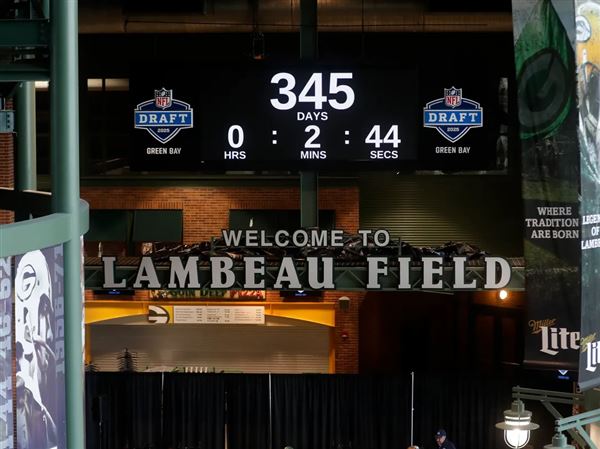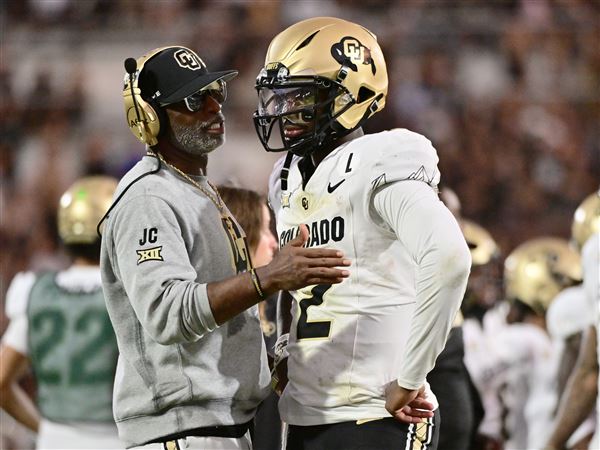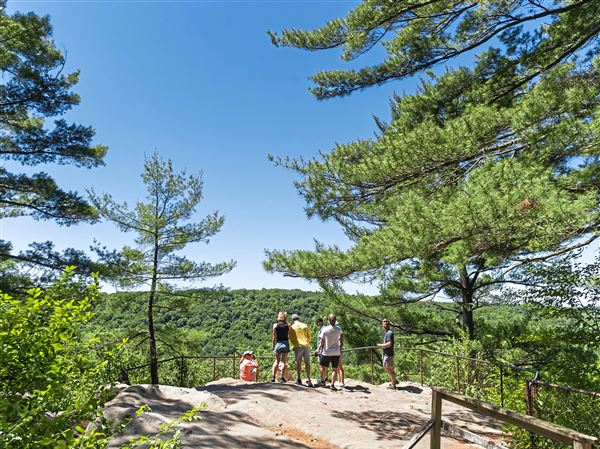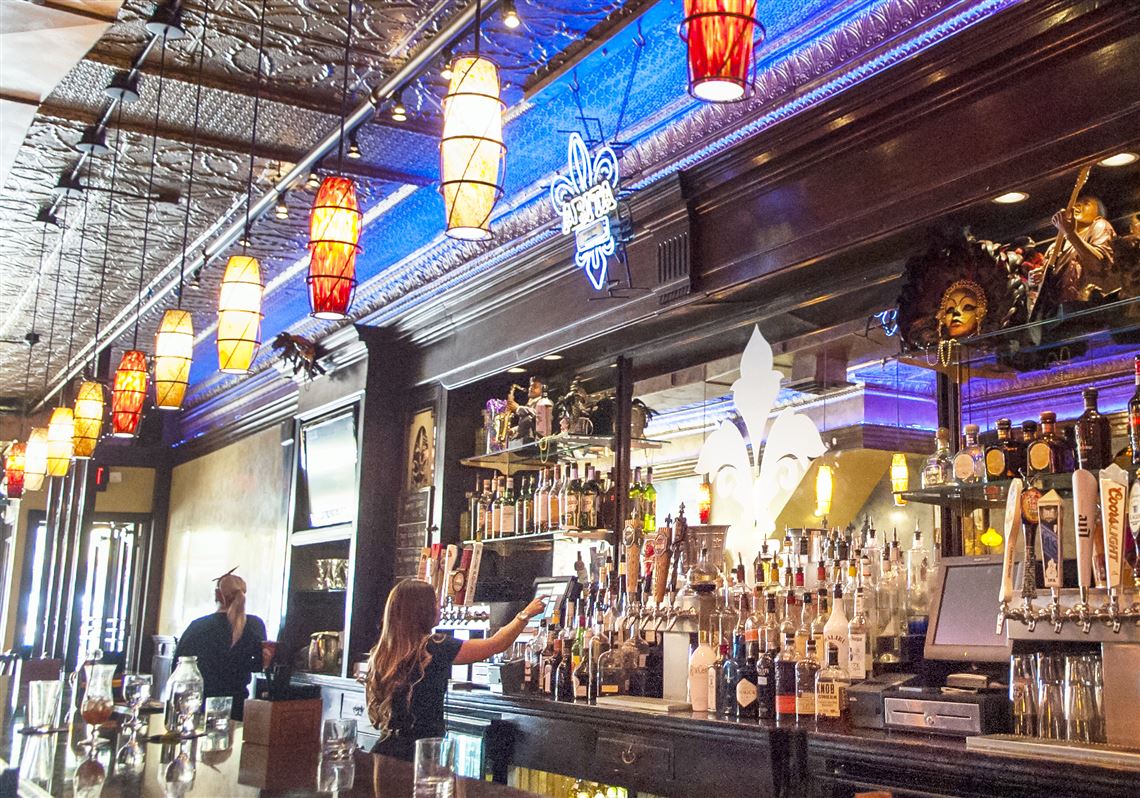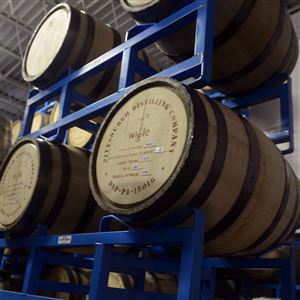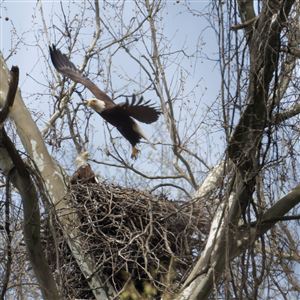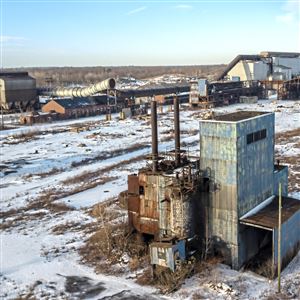A fella once told us that many of Pittsburgh’s stately, hand-carved bars went the way of the local workforce when the steel economy cratered in the 1980s: They packed up and they skipped town. Entire bars and their adjoining backbars were carefully dismantled, stuffed into crates and then shipped to buyers in New York, the West Coast, and who knows where else. Pittsburgh’s loss was the gain of imbibers across the country.
True? Apocryphal? Probably a bit of both. Even absent an economic cataclysm, the bar business is an unforgiving one, and most don’t stay in one place for too long. And even the stalwarts that survive the decades eventually, unceremoniously, fade away.
Take the lovely, dark-wood Brunswick Corp. backbar at Tasca Navarre, a tapas restaurant that opened in 2004 at 2623 Penn Ave. in the Strip District. With four carved columns, three mirrored panels and a floor-to-ceiling headboard made of red English oak, it was a striking specimen of woodwork.
Before it became Tasca Navarre, it was Charlie Bly’s for 22 years. Before that, it was called Nevros, a bar and sandwich shop, for 38 years. For nearly 66 years, the backbar had resided in the same spot.
“It was spectacular,” said former owner Charles Bly. On “the mirrors, the silvering was bad, but that just added a lot of character.” The 25-foot front bar, made of mahogany, was not part of a set, but the front and backbars complemented each other well.
Mr. Bly said he was told that the backbar, before it came to Nevros, resided elsewhere in the Strip District, perhaps a few blocks away at a long-defunct hotel. The backbar, he said, is probably more than a century old, and spent almost all of its life in the Strip.
“Froggy came out one time and took a look at it.” That would be Steve “Froggy” Morris, the late owner of the legendary, late Downtown nightspot known as Froggy’s, on Market Street. Mr. Morris was knowledgeable about bars and their histories, and he told Mr. Bly that he’d buy the Brunswick backbar for a few thousand — then he’d pack it up, take it to the West Coast and sell it for 10 times that amount.
Mr. Bly declined the offer, and the backbar remained in situ for years. But in 2010, after Tasca Navarre closed, the bar and backbar were sold to antique dealer (last he heard, the backbar is sitting in a Canonsburg warehouse).
“It was just a beautiful piece of the furniture,” Mr. Bly said. “I was almost heartbroken when they told me they were gonna come in and tear it up.”
Many of Pittsburgh’s most ornate bars are long gone, or have been substantially renovated. But some remain. And they’ve been complemented by a new crop of high-end, high-concept cocktail bars and restaurants as Pittsburgh’s dining scene reinvents itself with challenging, contemporary menus and million-dollar build-outs.
Here are 15 of our picks for some of Pittsburgh’s prettiest bars — a mix of new and old, that are open to the general public (no private clubs) and are not in any particular order.

The massive wall of whiskey at Butcher and the Rye, Downtown. (Post-Gazette)
1. Butcher and the Rye, Downtown
At Butcher and the Rye, which opened in 2013, they take top-shelf liquor literally — the back-lit backbar keeps some 400 bottles of whiskey and bourbon, and to reach the highest of the eight shelves, you’ll need to use the library-style ladder that slides through the bartending space; the hulking yet elegant woodwork has drawn comparisons to the eye-catching Brettos bar in Athens, Greece.
Just as impressive is the front bar surface itself, nearly a yard wide in spots, hewn from a single tree and meant to resemble butcher block.
Also take note of the unique, interconnected draft system, with beers on the left and draft cocktails at the mid-bar. And don’t miss the more delicate upstairs bar, framed by white subway tile and antique bar tools. — Bill Toland
• 212 6th St. • 412-391-2752 • butcherandtherye.com •
The bar at NOLA on the Square, Downtown. (Allison Farrand/Post-Gazette)
2. NOLA on the Square, Market Square
This story is probably too good to be true, but here goes: The backbar at the old 1902 Landmark Tavern, Market Square, originally came from the South Fork Fishing and Hunting Club.
Yes, that South Fork Fishing and Hunting Club, the one that sat above the mountain lake in Cambria County, owned by the steel barons and bankers who, for all of their money, failed to properly maintain the earthen dam on premises, leading to the 1889 Johnstown Flood. When the club disbanded, the bar was moved to Pittsburgh.
True or not, it’s the story that was told to Jerry Fink, an experienced cabinet maker and general manager at NOLA on the Square.
He helped to rebuild the 1902 backbar in the space into the Frankenstein beauty that sits there today, restitching some sections, and appropriating other elements from elsewhere in the restaurant, such as the etched-glass cabinet doors and the backbar wine cabinet that was rescued from the 1902 dining room. — Bill Toland
• 24 Market Square • 412-471-9100 • nolaonthesquare.com •

The Gandy Dancer Saloon in Station Square. (Pam Panchak/Post-Gazette)
3. Gandy Dancer Saloon, Station Square
The Grand Concourse is the stained-glass showpiece of the late Chuck Muer’s 1978 million-dollar rehab of the Pittsburgh & Lake Erie Railroad Station. (True story: Mr. Muer was lost at sea in 1993.) But the Gandy Dancer Saloon — named for railroad workers and track-layers who would have labored nearby — remains an elegant counterpart to the better-known restaurant.
The Gandy Dancer is now in its 37th year, but the bar that’s in place now is largely the result of a rehab job from about a decade ago: a long marble bar top, ornamental brass fixtures and railings and mushroom-shaped draft towers, and frosted windows etched with the bar’s mustachioed namesake. A clock, a safe and some railroad company signage are remnants from the building’s original incarnation. — Bill Toland
• 100 W. Station Square Drive • 412-261-1717 • gandydancersaloon.com •

A close-up of a section depicting the U.S. Steel Homestead Steel Works, part of the stained glass mosaic bar top at Blue Dust in Homestead. (Dan Gigler/Post-Gazette)
4. Blue Dust, Homestead
Van Gogh’s “Starry Night” meets the industrial revolution in a 15-foot mosaic of the U.S. Steel Homestead Works — meticulously created from thousands of pieces of stained glass broken by hand — that brings a bolt of color to the bar top at Blue Dust in Homestead.
Named for the blue-gray iron ore powder once used in steel production just across the train tracks, Blue Dust’s building has a history as colorful. Over a century old, it was said to be a well-known brothel in an infamous Mon Valley red-light district. Since 2008, it’s a family-owned establishment helmed by “Uncle” Jerry Miller.
The mosaic, created by Mr. Miller’s sculptor daughter Sarah Cunniff, abstractly depicts the Homestead works from end to end (along with some other small flourishes such as a turtle and a sea dragon — the Monongahela Monster?) in a dozen colors. It took a month to create.
“You’d have to do some kind of complicated algebra equation” to estimate just how many pieces of glass were used, Ms. Cunniff said.
It’s protected by a 2-inch layer of polyurethane and rests on a stained-birch bar the family built themselves, as they did with the backbar’s wooden casing for the 24 taps (in a bar whose motto is “no crap on tap”). The shelving for premium liquors and jars of infusions are cut from pieces of salvaged marble. — Dan Gigler
• 601 Amity St. • 412-461-6220 • bluedustpgh.com •

The bar at Station restaurant in Bloomfield. (Michael Henninger/Post-Gazette)
5. Station, Bloomfield
The recently opened Station was also once home to a notorious neighborhood problem bar where the ownership is said to have run a house of ill repute, and it was painted jet black from floor to ceiling.
That was before Frank D’Amico bought the property in the late 1970s and returned the century-old hand-carved wooden bar back to its original grandeur, after painstakingly stripping the black paint and restoring it to its original warm cherry finish. With its massive mirror of two-inch-thick leaded glass and striking columns, the bar would be a centerpiece of D’Amico’s, a Bloomfield institution for three decades.
Station co-partner John Pieranunzi wants to continues Mr. D’Amico’s legacy at the property of a “timeless but updated” neighborhood place, and that’s reflected in the bar itself. Built out of wrought iron with a wooden veneer by John Walter of Iron Eden (also in Bloomfield), the steel top is treated with olive oil. Over time it gives the bar surface a leathery, aged look and feel, which matches the character of the backbar.
Said Mr. Pieranunzi, “Once John finished building it, the first words out of his mouth were, ‘It looks like it’s been there forever.’ And he’s right. He did a tremendous job.”.” — Dan Gigler
• 4744 Liberty Ave. • 412-251-0540 • www.station4744.com •

Glenn Miller (left), his sister Stacy Miller (center) and Alison Kaelin, all of Observatory Hill, toast with beers as bartender Patrick Madden watches. (Bill Wade/Post-Gazette)
6. Max’s Allegheny Tavern, North Side
Of the many hallowed beer halls on this list, Max’s Allegheny Tavern feels most like a snapshot out of the past and the proof is on the dining-room wall.
A pre-World War I-era photograph depicts men and a few women gathered around the same stately wooden bar, under the same tin ceiling, next to the same wooden Gloekler Refrigeration icebox, standing on the same ornately patterned hexagonal penny-round tile from when it was the ground floor of the Rahn Hotel, established in 1903. If you swapped the men’s bowler and derby hats for Pirates and Steelers caps, you might not know the difference to the present day.
The massive hand-carved backbar was purchased at the St. Louis Exposition and shipped to Pittsburgh via rail. Three of the four beveled- and leaded-glass mirror panes are originals and were long ago adorned with bright pinkish-red ribbons of neon lights, and flowers are carved into the columns behind the mirrors. The antique iceboxes were converted to electric and are still in use today. Gas lamp fixtures are still in the ceiling, but era-appropriate Tiffany lamps hang from them now.
Among scores of artifacts and framed ephemera lining the walls is the 1893 license to sell “Vinious, Spiritous, Malt or Brewed Liquors At Retail” for the former Farmers and Drovers Hotel (now the dining room). Another, a charcoal drawing of Max Rahn, presiding over a collection of antique German steins. Then, as now, the operation is a family one: longtime owner Bill Deigelman recently turned over the reins to his sons Doug and Andy. — Dan Gigler
• 537 Suismon St. • 412-231-1899 • maxsalleghenytavern.com •

Detail of the metalwork on the tap system at Dorothy 6 Blast Furnace Cafe in Homestead. (Post-Gazette)
7. Dorothy 6 Blast Furnace Cafe, Homestead
The recent narrative of Greater Pittsburgh is that of a region bounding toward the future, having long turned the page on its industrial past. But nostalgia is never far from the mind’s eye around here, and they do it well at the Dorothy 6 Blast Furnace Cafe in Homestead, where the slogan is, “If we can’t pour steel, we'll pour beer.”
Named for the massive fire-belching hearth at the U.S. Steel Duquesne Works, the bar is a contemporary homage to the smoky days of yore.
The poured-concrete surface is inlaid with the company logos of five mills where owner Tom Kazar’s family members once toiled: U.S. Steel, Mesta Machine, Dravo, Jones & Laughlin and Levinson. The bar’s edge and foot rail are fitted with rails from the U.S. Steel Homestead Works that once stood nearby. The shelving is made from the gears of a 19th-century machine from Lima, Ohio, cut up by Mr. Kazar, who also fashioned the tap handles from railroad spikes and chain links. — Dan Gigler
• 224 E. 8th Ave. • 412-205-2131 • dorothysix.com •

A patron at the bar of James Street Gastropub & Speakeasy on the North Side. (Dan Gigler/Post-Gazette)
8. James Street Gastropub & Speakeasy, North Side
A phalanx of lions carved into the tops of the African mahogany cabinetry at the James Street Gastropub & Speakeasy suggests a regal history and indeed that is the case.
Carved by a neighborhood craftsman in 1926 (during Prohibition) for the then princely sum of $3,000 ($39,784 today, according to the Consumer Price Index inflation calculator), it was part of an upstairs speakeasy and was later brought down piece by piece and reconstructed in the downstairs space where it now sits.
Nicks, scrapes, and scratches atop the bar, smoothed by time, create a patina of nearly 90 years of Pittsburgh barroom history. The oak paneling around it came from a mansion in nearby Manchester.
Craig Poole, who owned it for 17 years as the James St. Tavern, said that Art Rooney Sr. once also owned the building, which dates at least to 1898 (the original deeds were destroyed in a fire). Founded as a bicycle and clock shop, the top floor was once also a secret meeting spot for socialist and labor groups.
In the decades since, it’s had many names, notably Wiggin’s, Julian’s and the James St. Tavern — where legends like George Benson, Stanley Turrentine, Jeffrey Osbourne and the Preservation Hall Jazz Band graced the stage.
Mr. Poole, who owned it for 17 years as the James St. Tavern, is happy that the current owners, the Saftner family, are maintaining its tradition as a hub of local music.
“I’m so glad they’re doing well and the musicians have a place. The memories made are more important than so many other things.” — Dan Gigler
• 422 Foreland St. • 412-904-3335 • jamesstreetgastropub.com •

Dish Osteria on the South Side. (Post-Gazette)
9. Dish Osteria, South Side
Dish Osteria, one of Pittsburgh’s most consistently appealing restaurants, gives off a glow. The corner building on South 17th Street is set among nondescript South Side row houses, a block back from the cacophony of East Carson Street. Warm yellow light emanates from the front and side windows as you approach, beckoning you inside. Open the door, enter and — instant sanctuary.
You are welcomed by a gleaming copper-top, fronting a long oak bar stained a deep red. The 20-foot mirror accentuates more than 100 bottles of spirits. Nooks contain taps for 10 beers of integrity, open bottles of well-chosen Italian wines and an enlightening assortment of Italian herbal liqueurs known as amari in the plural.
Founded in 1999 by Michele Savoia, a native of Sicily, and his all-American wife Cindy, Dish occupies a location that has been a tavern since 1885. Mr. Savoia married well: His father-in-law, Peter Nofsinger, is a carpenter by trade. He built the impressive wooden bar that befits the room’s Victorian-era details and sets the tone for the casual excellence that awaits diners and drinkers.
The copper bar top was crafted by Ralph J. Meyer Co. of the Strip District, “and everyone loves the copper-top,” said bartender Christi DiLeonardo. “I can’t tell you how many customers talk about it.” Some old-timers still wander in with memories of McCann’s, the classic Irish neighborhood pub that held down the spot from 1946 until Dish opened. Mr. Savoia loves to greet them, and happily points to historic continuity: a ceramic leprechaun from McCann’s is tucked into a high corner, presiding over the conviviality. — John Allison
• 128 S. 17th St. • 412-390-2012 • dishosteria.com •

Richard Ward, left, of Lawrenceville, and Katharine Perry of the Strip District at Tender Bar + Kitchen in Lawrenceville. (Bill Wade/Post-Gazette)
10. Tender Bar + Kitchen, Lawrenceville
In her 2013 review, Post-Gazette restaurant critic Melissa McCart called Tender’s bar a “stunner” — an apt description for the 25-by-12-foot walnut and glass backbar with a library that showcases 300 often rare spirits from around the world in the 121-year-old former Arsenal Bank building in Lawrenceville.
The bar top itself is fashioned from an original marble wainscoting that was removed and repurposed. Adjacent to the bar, a bundle of checks found in the attic dating from 1895-99 were added to the wall decoupage mural. Other furnishings and decor reflect the period.
Designed by neighboring Moss Architects and built by National Woodwork in Windgap, owner Jeff Catalina said the idea was to put on full display not only the liquor collection but also the folks making the drinks.
“Getting input from bartenders was key,” Mr. Catalina said. “One thing we did very intentionally was putting the service bar in middle — they get to show off the drinks being made and set out for delivery.” — Dan Gigler
• 4300 Butler St. • 412-402-9522 • tenderpgh.com •

Detail of the bar and the wine tap at Carmella's Pints & Plates on the South Side. (Dan Gigler/Post-Gazette)
11. Carmella's Plates & Pints, South Side
Beer, wine and whiskey literally flow from the barrel at Carmella’s, where the tap system is encased by vintage wine barrels, purchased at an auction and fashioned into functionality by co-owner Mike Alberter.
Mr. Alberter’s antiquing is the source of many of the pieces around the bar: a Depression-era fire-hose nozzle above the taps; a Prohibition-era prescription for legal alcohol consumption; a taxidermy buffalo head; and a panoramic picture of a World War I American infantry division.
But his best find might be a set of six stained glass pendant light fixtures from 1926 that glow with golden warmth above the refurbished custom maple and granite bar and cabinetry that anchored the Inn Termission Lounge for 30 years. The slate floor and copper work above the bar provide a stately complement to the rustic cedar paneling and shelving of the back bar that Mr. Alberter created in his North Side studio. — Dan Gigler
• 1908 E. Carson St. • 412-918-1215 • Carmella's Plates & Pints on Facebook •

The bar at Grit and Grace, Downtown. (Post-Gazette)
12. Grit and Grace, Downtown
It might take more than one visit to Grit and Grace to realize that the intricate slotted canopy that is suspended over portions of the dining room actually extends to the bar area of the new Downtown restaurant, and becomes the shelving for the backbar. It’s more a piece of artwork than a conventional backbar.
The corrugated chicken-wire glass (it resembles a honeycomb) that supports the front bar surface was supposed to have come from a Downtown demolition job; principal architect Felix Fukui had held onto the salvaged glass for years, waiting for the right project.
But before the glass could be delivered to Grit and Grace, the panels tipped over and broke, so Mr. Fukui and restaurant co-owner Rick Stern had to find replacements online. — Bill Toland
• 535 Liberty Ave. • 412-281-4748 • gritandgracepgh.com •

Detail of the bar at the South Side Barbecue Co. (Bill Wade/Post-Gazette)
13. South Side Barbecue Co., South Side
When asked what the century-plus-old wooden backbar at his South Side Barbecue Co. might say if it could talk, owner Pat Joyce conceded with a wry smile, “I’m pretty sure it’d be incriminating.”
The bar already was decades old when it was moved from a nearby establishment in 1943 to become the centerpiece of Al Bendict’s Tavern. The circa-1880s building was once a butcher shop, a penny candy store — and a secret passage to an after-hours speakeasy.
One of the leaded-mirror panes is an original and, along with the frosted glasswork across the top and the cabinet doors and panes, survived a period in the late 1970s and ’80s when the place drew an unruly biker crowd. That ended in 1988 when new owner Sam DeRoss changed the name to the 17th St. Cafe and told the bikers they were persona non grata, according to Mr. Joyce, who worked for Mr. DeRoss, and took ownership in 2001. — Dan Gigler
• 75 South 17th St. • 412-381-4566 • southsidebbqcompany.com •

Bartender Kristina Meyer behind the bar at Pints on Penn in Lawrenceville. (Dan Gigler/Post-Gazette)
14. Pints on Penn, Lawrenceville
Pat Maher can pinpoint exactly when he had the “good-God-what-have-I-gotten-into?” moment that seemingly befalls every first-time bar owner: when the floor was completely torn out of the former Kopec’s in Lawrenceville and the antique backbar was ratchet-strapped in place to the wall and covered with a tarp, suspended above the basement.
That quarter-sawn white oak back bar, with intricate hand-carved woodwork and a leaded glass mirror, survived the remodel — as has everything else since at least the (Teddy) Roosevelt administration — to be the centerpiece of Pints on Penn, opened roughly six weeks ago.
A building history search revealed the structure has housed saloons for nearly all of its 140 years and the handsome backbar is believed to be original to the building. Stained glass windows salvaged from the old layout hang prominently below an original tin ceiling. A new oak bar by Kennedy Contracting incorporates carved wooden elements from the original into the front panels. — Dan Gigler
(Editor’s note: Post-Gazette photographer Matt Freed is a partner in this business.)
• 3523 Penn Ave. • 412-945-7468 • pintsonpenn.com •

Detail of Mallorca Restaurant’s bar on the South Side. (Bill Wade/Post-Gazette)
15. Mallorca, South Side
For most, Mallorca, a Spanish-Portuguese restaurant on the South Side, is a special-occasion dinner place, and not a spot where you’re likely to belly up to the bar.
But what a bar it is.
It was built out of reclaimed, locally sourced odds and ends before that sort of thing was trendy (in the early 1980s), when the storefront was occupied by the Brady Street Bridge Cafe. The dark-wood backbar double archway was taken from a North Side home, as were the two pocket-style French doors that were laid horizontally, fashioned together, and now make up the base of the front bar.
As small bars goes (it seats about 10), it’s one of our favorites. — Bill Toland
• 2228 East Carson St. • 412-488-1818 • mallorcarestaurant.com •
Dan Gigler: dgigler@post-gazette.com; Twitter @gigs412; John Allison: jallison@post-gazette.com
First Published: October 15, 2015, 4:00 a.m.

